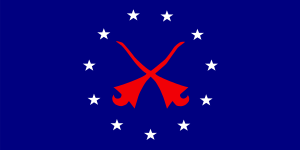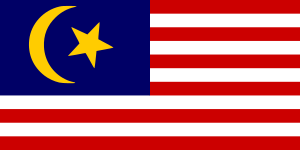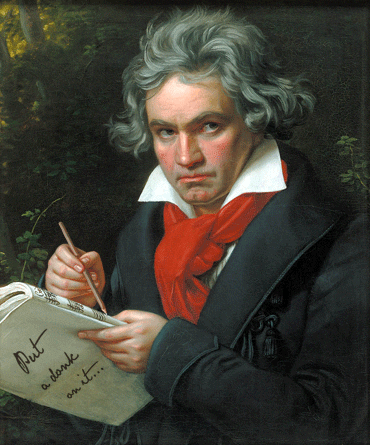By: Nimue Wafiya
“Why does the Malaysian flag look so boring?”
“Why does Negaraku not bang like Smells Like Teen Spirit?”
Everyone has these questions, and they’re good dinner table talk. So, let’s dive in.
Our flag is boring?
Picture this: You’re in school and Hari Merdeka is approaching. Seni has just begun and the teacher just handed you an A4-sized paper with an outline of a flag you’ve seen waving outside of school, on most of your textbooks, the one you painstakingly track every perhimpunan to see whether or not it’s being raised by the pengawas at a constant speed perfectly proportional to that of the national anthem, Negaraku. You stare at the box of colour pencils your teacher has provided and you see that the blue, red and yellow ones have been sharpened to the size of your pinky, and you can’t even recognize the brand but you already know the color won’t show even if you press hard; with palpable envy, you stare at your friend’s Faber-Castell colour pencils.
(Glossary: Seni = Art class; Perhimpunan = Assembly)
You think to yourself that it’s such a simple design, with the canton being the only tedious feat as the royal blue must cover the nooks between the points of the stars – ouch. But overall, you knew it was mindless work. You were aware that come time for the stripes to be filled, all you have to do is reconfirm that the stripes start with red so you can finish this piece a little cincai. Yes, it’s a boring flag, but it’s easy to color. And there we have it, a segue way into why flags have to be boring: they’re cheaper and easier to mass produce. So, the overall simplicity is justified. Which then begs the question: why the 4 boring colors? (one of which you don’t even have to color in, Thank God).
The red, blue and white are colors that represent Malaysia as a country belonging in the Commonwealth while the yellow of the star and crescent is the royal colour of the Malay rulers. However, it’s generally known that purple is the most recognized color when it comes to royalty ⎼ Queen Elizabeth I forbade anyone except close members of the royal family to don it, purple was the color of rulers of the Byzantine Empire and the Holy Roman Empire, and later by Roman Catholic bishops. Purple is an exclusive color. In the olden days, the dyes were extracted from tiny mollusks – approximately 336,000 snails yielded one ounce of the dye, such labor obviously cost a ton. So purple became the provenance of kings, queens, nobles and wealthy, powerful patrons and the prestige and history of the color has stuck ever since. If this is true, why didn’t Malaysia hop on the bandwagon? Why yellow?
Yellow is a reminder that the Malay Rulers are independent of foreign control; yellow is our unique color, and also, a yellow moon and star against dark blue? That just looks right.
But the Jalur Gemilang didn’t just come to be. There was a call for action for residents of Malaysia to design the nation’s flag. The submission period lasted one whole month, beginning on the 10th of August, 1949. Out of 373 designs submitted (a shockingly small total), 3 were selected to be presented to the deciding committee.



On the 19th of April 1950, with advice from the Federal Legislative Council and upon the agreement from the Royal Federation of Malaya, the flag we know today was chosen to represent our country. Jalur Gemilang was designed by Mohamed Hamzah, a 29-year-old architect who worked for the Public Works Department (JKR) in Johor. The 14-point star and stripes were introduced closer to Hari Malaysia, when all 14 states were recognized – at the time, Singapore was still a part of Malaysia, now the 14th component is considered the Federal Government as a whole.
Flag: Verdict?
It is a boring flag. We couldn’t stray too far from the colors of the British Empire and were limited by methods of mass production. But honestly, I wouldn’t want our flag to look any other way. I appreciate the equality of each color in our flag, that all four colors take up about the same area. Plus, rebranding an entire nation sounds like too much work and should probably be left to reddit forums, like this one: https://urlzs.com/3jKxr or even as a fun seni project!
Our flag is what it is
White for honesty. Blue for unity. Red for resilience. Yellow for, well, these days, a duality of old and new thinking (more on that here: https://urlzs.com/KGJr3 ).
It’s a little sad, but a lot of Malaysians can look at this flag and feel nothing. A lot of people outside the country see our colors and symbols and think: corruption, havoc. But hey, if you could look at a red traffic light and stop, why not train yourself to look at our flag and recall those positive adjectives instead of drawing a blank or drawing something negative. For the most part, we’ve got proactive youth shaping a pretty bangin’ nation. From making our young debaters go viral for their efforts to bring down the voting age to 18 (we did it) to having R.AGE, Malaysia’s own youth news and lifestyle platform, winning Google Malaysia’s Google News Initiative (GNI) grant.
A symbol is only as strong as the image it elicits. For those who’ve lost hope, it’s worth reinforcing the virtues of our boring flag. For those who have yet to develop a picture of our country: try to make a good one. Patriotism these days have a bad rep, but there’s just something wrong about not lifting up a nation that is essentially: a bunch of different people with different traditions, food, languages and dialects.
Our song is boring?
Most national anthems are rooted in ambition and loyalty, like ours. Some come off a little too aggressive, like Japan’s Kimi Ga Yo, which literally contains the lyrics: “The path to glory is built by the bodies of our foes!”. Some are a little too specific in their show of patriotism, like Italy’s Il Canto degli Italiani whereby the “Austrian eagle” is sung in reference to the Austro-Hungarian Empire that the Italians had to fight to conquer independence; the fight is not ongoing, but Austria remains part of the song. But what all national anthems have in common is the timeless, classical charm that comes when the recording of the ensemble plays. It’s not something we would listen to for a good time but it’s something we can listen to. Having an orchestral composition, as opposed to anything contemporary, as a national anthem is also the best way to honor our diligent experts in music.
As much as Negaraku can put us to sleep (no shade), this seemingly insipid song actually has quite the backstory, and that has got to count as some kind of gamechanger.
Tracking the timeline of our national anthem:
- On Tunku Abdul Rahman’s suggestion, a worldwide competition was launched to find the perfect national anthem. 514 entries were received but none were deemed suitable.

2. The deciding committee then invited a few reputable composers from around the world to compose something that would hopefully be more suitable; none were.

3. In the end, Perak’s National Anthem was selected on account of it’s “traditional flavor” – the lyrics were altered by the committee which included Malaysia’s first prime minister
How did Perak’s National Anthem, ‘Allah Lanjutkan Usia Sultan’, come to be in the first place? There is no definitive answer but the speculations are pretty hilarious. The most probable scenario is as such: The tune of Negaraku had been very popular on the island of Mahé in the Seychelles, where the Sultan of Perak had formerly been living in exile. Some rumours claimed that he heard it at a public band concert on the island, a song to a popular French melody claimed to have been composed by the lyricist Pierre-Jean de Béranger (1780–1857).
Another rumor is that when Sultan Idris Murshidul’adzam Shah, ruler of the State of Perak from 1887 to 1916, represented the Malay Rulers of the Federated Malay States at the Coronation of King Edward VII in 1901, his protocol officer was asked what his state anthem was. Realising that his state did not possess an anthem, he, in order not to appear underdeveloped in front of his hosts, proceeded to hum that same French tune.
The truth has yet to reveal itself to us. But as of now, we can simply appreciate the flag and song we’ve known for the past 62 years. Happy Merdeka!



